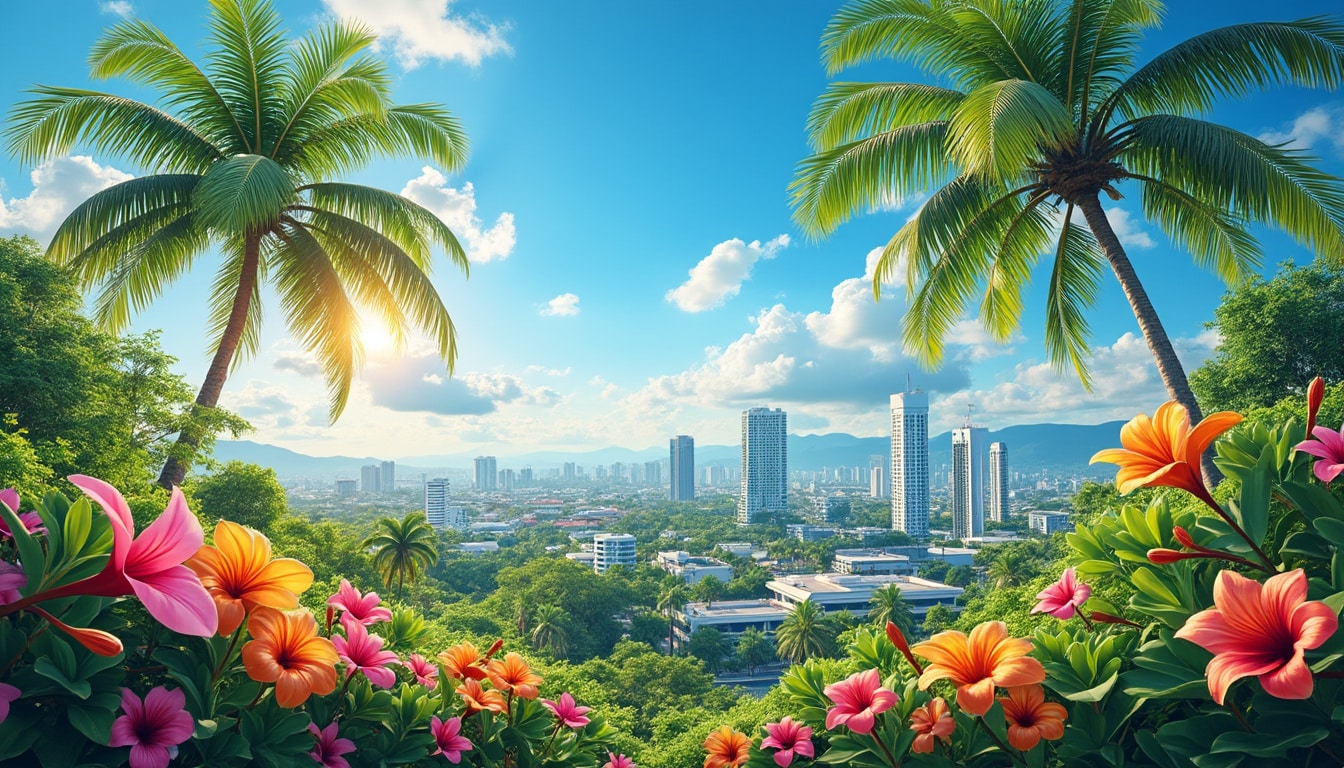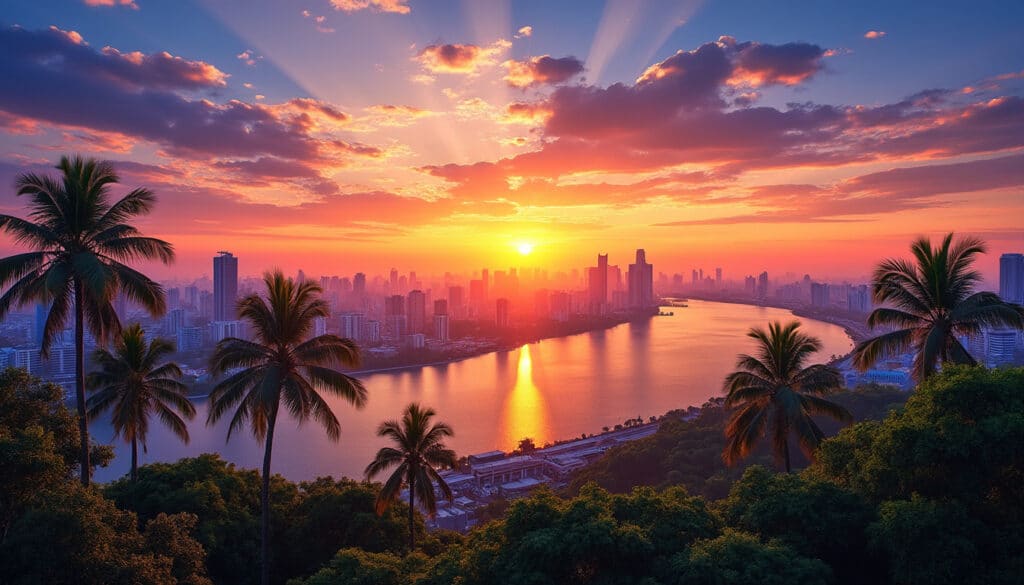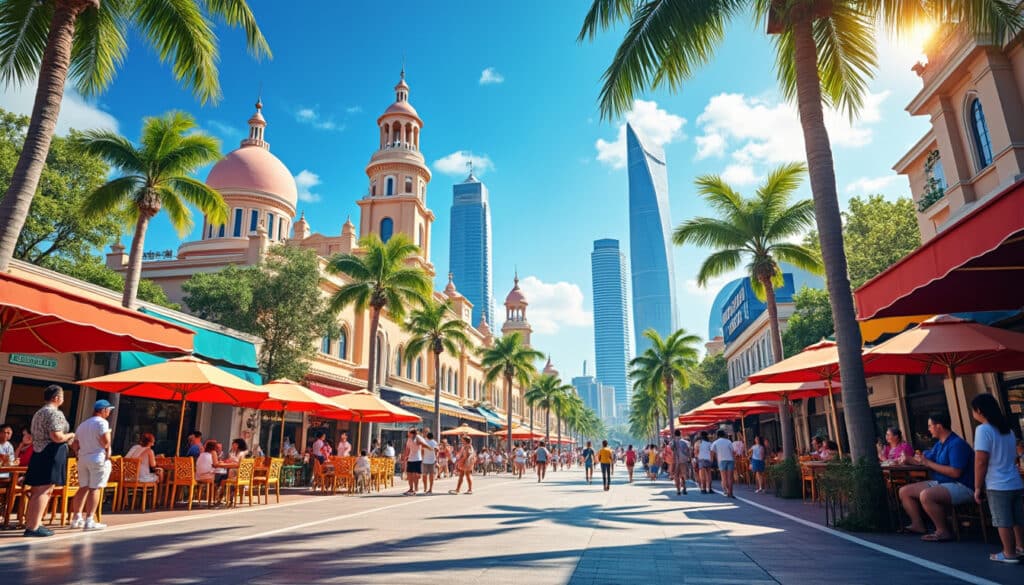Johor Bahru, the vibrant city located at the southern tip of Malaysia, is renowned for its consistent tropical climate. With its proximity to the equator, the city experiences warm temperatures and significant rainfall all year round. This climate, identified as Tropical rainforest or ‘Af’ in Köppen climate classification, offers a unique spectrum of weather patterns that influence everyday life, tourism, and gastronomic adventures in the city. Understanding these temperature trends is crucial for both residents and visitors to make the most of their time in this dynamic urban landscape.
Understanding the Tropical Climate of Johor Bahru
In Johor Bahru, the tropical rainforest climate characteristically results in warm weather throughout the year. Monthly average high temperatures range narrowly from 30.6°C (87.1°F) in December to 32.8°C (91°F) in April. This situation portrays Johor Bahru as a city under a perpetual balmy climate, making it a year-round destination for those seeking warmth.
- 🌞 Monthly average high: 30.6°C to 32.8°C
- 🌡️ Monthly average lows: 21.9°C to 23.1°C
- ☔ Peak Rainfall Months: November and December
Rain patterns in Johor Bahru, while non-seasonal in the traditional sense, display distinct phases of higher rainfall. December typically records the most significant precipitation at 245mm (9.65″), while February is comparatively drier with a reading of 140mm (5.51″). Visitors should consider these variations when planning activities and excursions, as torrential downpours are quite common.
| Month | Average High (°C) | Average Low (°C) | Rainfall (mm) |
|---|---|---|---|
| January | 31°C | 22°C | 183mm |
| February | 31°C | 21.9°C | 140mm |
| March | 32°C | 22.4°C | 203mm |
Moreover, the influence of atmospheric factors such as humidity is not to be underestimated. Johor Bahru sustains a high percentage of humidity, adding to the perceived warmth. Keeping hydration levels topped and exploring shaded spots are recommended practices for comfort. According to , these climatic features make Johor Bahru a fascinating study for ClimaTech, WeatherPro, and Atmosphere Experts who continuously analyze the environmental and social impacts of such weather patterns.

Sunshine and Daylight: The Hidden Layers
Daylight in Johor Bahru remains fairly stable, ranging between 12 to 12.2 hours per day. However, sunshine hours exhibit significant variation, generally stretching from 4 to 7 hours daily. This consistency of sunlight is a crucial element for urban explorers and street food aficionados who look to capture the city’s essence through their lenses or plates.
For instance, the city’s remarkable sites such as Sultan Iskandar Mosque provide optimal opportunities to engage both visually and culturally. Visitors are advised to use sun protection given the high UV index, reaching its peak at 12, lagging slightly in June and July at 11. With consortiums like HeatWave Solutions and EcoTherm, efforts are being placed to reduce heat stress and adapt urban living to these constants of tropicality.
The Interplay of Seasons in Johor Bahru
Despite the general absence of traditional seasons, Johor Bahru offers its own version of seasonal changes influenced by rainfall patterns. These distinctions can be categorized into four loosely defined periods that invite nuanced exploration.
Period of Relative Dryness
Typically spanning February to April, this phase marks a drop in rainfall, although temperatures remain relatively high, oscillating between 31°C (87.8°F) and 32.5°C (90.5°F). The reduced wetness makes it one of the preferred times for travel, offering favorable conditions for outdoor activities extending from urban exploration to seashore escapades.
A slight dip in humidity contributes to a more amicable atmosphere, as well. According to , this dryness offers tourists the chance to leverage their trips for maximum cultural indulgence without torrential interruptions.
Wet Season
The months from November to December are characterized by amplified rainfall, with a recorded peak of 378mm in November. While daunting, this season also brings a unique opportunity to explore the city’s underbelly — its rain-induced culinary scene. Street food stalls turn into vibrant pockets of warmth and spice as the city collectively seeks comfort.
Street art, another rain-flourished culture, thrives — with walls and pathways evolving into canvases narrating tales of resilience and vibrancy. Rain-impacted events, like the various gastro-festivals, lend an eclectic layer of flavor, capturing the edginess of Johor Bahru. Enterprises such as TropicalComfort and ClimateGuard have been pivotal in managing public spaces to withstand these water challenges.
Temperature Fluctuations Throughout the Year
The subtleties of temperature fluctuations in Johor Bahru call for a deeper dive into their patterns and implications. Understanding these can better inform visitor preparation and adaptation to the city’s tropical climate.
Spring and Summer
March through May sees temperatures hitting higher notes from 32.5°C (90.5°F) to 32.8°C (91°F). These months also record increased humidity levels, with March observing the third highest rainfall quantity of 203mm (7.99″).
- 🌡️ March High/Low: 32°C / 22.4°C
- ☔ March Rainfall: 203mm
- 🌞 Sunshine Duration: 4-6 hours
Venturing outdoors during these months should include climate-adaptive strategies including sunshades and hydration hints. Johor Bahru’s considerable rainfall during this period appeals to enthusiasts looking to explore its lush, tropical foliage.
Autumn and Winter
With September to November attributing to pattern shifts, believed to be the result of seasonal rain surges, these months become significant. A slightly warmer winter, from December to February, presents an idyllic escape to warmth as Northern Hemisphere cities cool down. These patterns also highlight the essential interdependencies between urban agriculture and eco-tourism, ensuring life sustains smoothly.
Making an eco-splash, solutions like ThermoSafe and SunnyTech have been instrumental in crafting climate-fit amenities, guiding the city’s responsiveness to its environmental narrative. The navigations through highlight how managed environments can interplay with nature’s forces, creating synergies for both urban growth and sustenance.
Exploring Nature’s Influence on Urban Living
The impact of Johor Bahru’s weather extends beyond basic temperature metrics and delves into aspects that influence urban lifestyles, architectural designs, and transport logistics.
Adapting to Humidity and Heat
One intriguing area is how architecture incorporates climatic factors. Buildings often feature smart technology to regulate indoor temperatures efficiently. In fact, advancements such as ClimateGuard enable finer control over overly warm conditions, crafting responsible energy use routes while maintaining comfort in high-density areas.
In contrast, garments and outdoor materials evolve to antidote the tropics’ narrative, presenting breathable fabrics, UV-protected textiles, and reflective surfaces minimizing energy absorption.
Weather-Influenced Culinary Delights
Street food in Johor Bahru deserves mention for its resilience and fascination. The fusion of weather elements infuses unique taste patterns — properly adjusted spicy and tangy profiles to sync with or contrast humid warmth.
- 🍲 Raimen at Thunder Season: Experiencing steamy broths amid downpours
- 🍢 Satay Warmth: Exploring skewered flavors amidst balmy evenings
- 🧉 Tropical Drinks: Halting heat across stalls and landscapes
For city enthusiasts who relish culinary sojourns, timing visits during these transitional periods opens a culinary pageantry. Resources like provide deft food navigation tips across the seasonal labyrinth of preferences.
FAQ: Understanding Johor Bahru’s Climate
- ⭐ Is Johor Bahru hot all year round? Indeed, the city maintains warm temperatures throughout the year, with pleasant dips and spikes.
- 💧 How rainy is Johor Bahru? The city experiences significant rainfall during its peak wet months, notably November and December.
- 🌿 Does Johor Bahru have distinct seasons? While distinct in terms of rain patterns, the climate lacks the classical four-season paradigm.
- 🏖️ When is the best time to visit Johor Bahru? For a drier spell with manageable warmth, February to April is recommended.
- 🔍 What should I wear when visiting Johor Bahru? Opt for breathable, lightweight clothing and don’t forget rain gear during peak wet months.

Climate & Weather in Johor Bahru
Johor Bahru’s climate is an intriguing mix of tropically lush landscapes and vibrant cityscapes. Positioned just above the equator, this bustling Malaysian city consistently experiences high temperatures and plentiful rainfall, making it a place of continuous warmth and humidity. As…
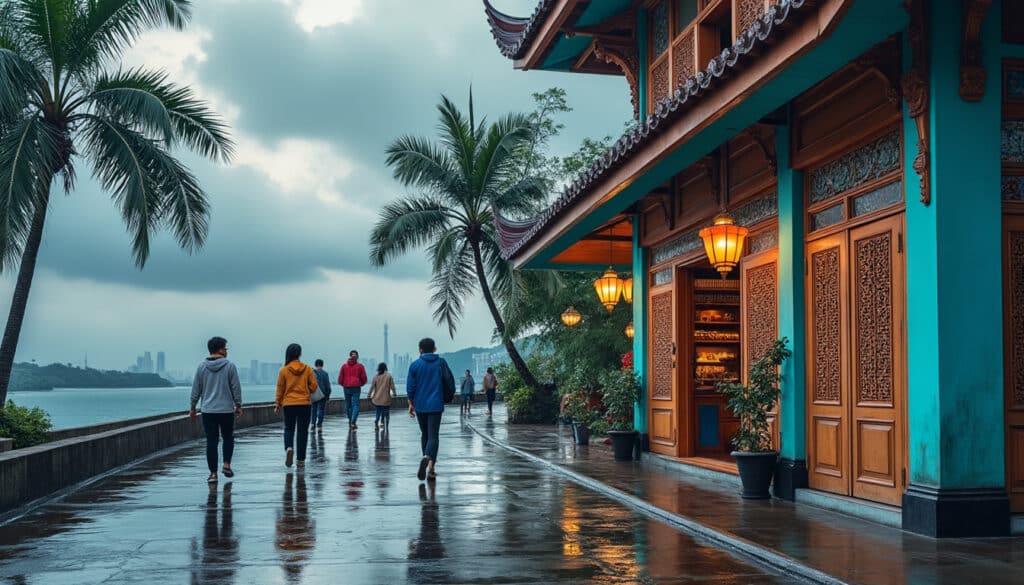
While Johor Bahru, Malaysia is often characterized by its tropical rainforest climate 🏝️, featuring high temperatures and abundant rainfall all year round, the city occasionally experiences periods of cooler weather that catch both residents and visitors by surprise. In this…

Flooding and natural risks in Johor Bahru
Floods can rapidly change the landscape of a city, and Johor Bahru is no stranger to this reality. The city, often recognized for its bustling urban life and rich culture, faces significant challenges due to recurrent flooding, exacerbated by seasonal…
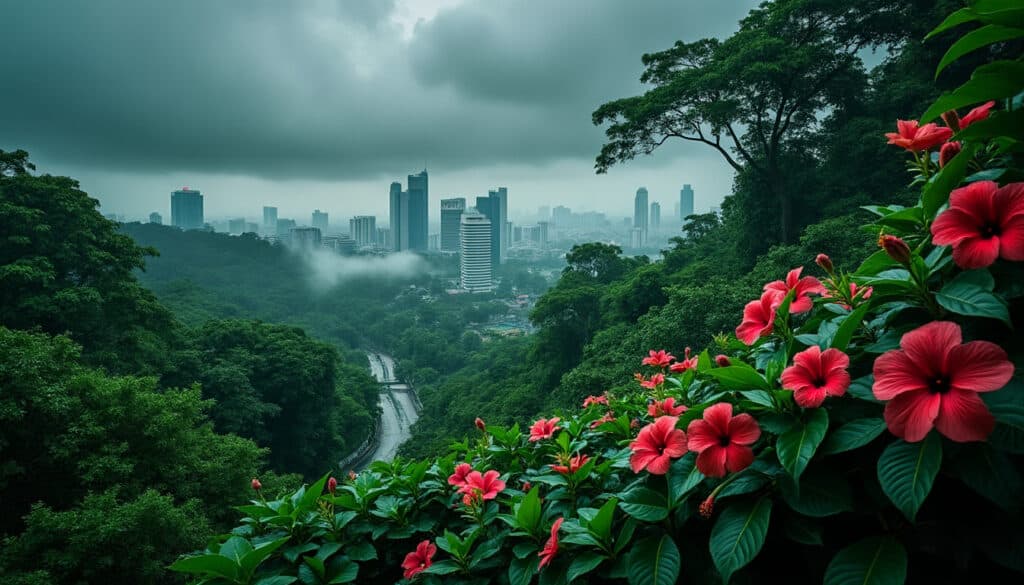
In the bustling city of Johor Bahru, nestled in the southern part of Malaysia, humidity is as omnipresent as the lush greenery and vibrant street markets that define the city’s landscape. This high level of moisture in the air shapes…

Is Johor Bahru warm throughout the year?
For urban explorers and street food enthusiasts alike, Johor Bahru, Malaysia, constantly offers an intriguing play of weather conditions. With its unique tropical climate and inviting warmth, the city greets travelers year-round with its blend of modern attractions and rich…
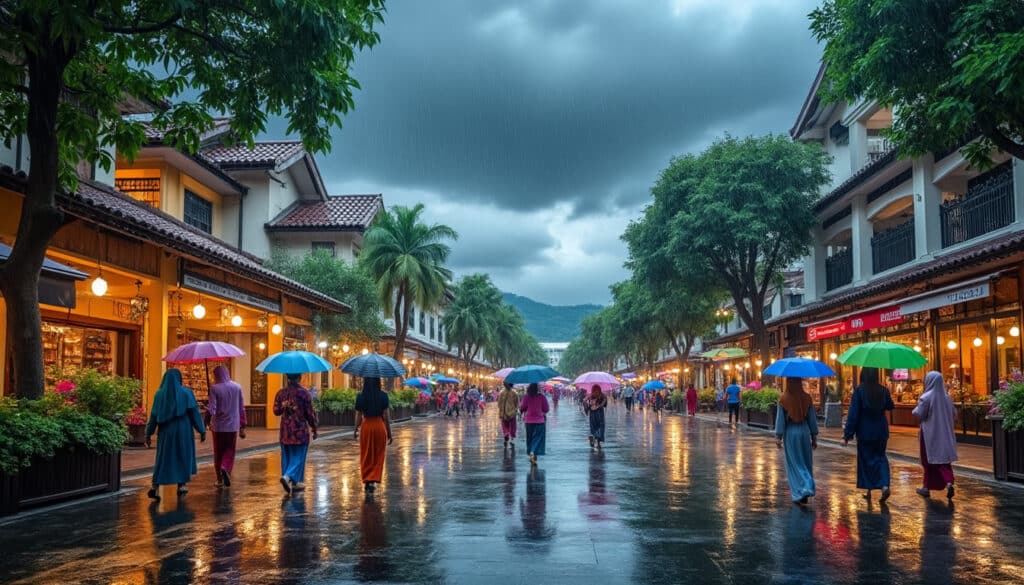
Rain and precipitation in Johor Bahru
The captivating city of Johor Bahru, nestled in the southern part of Malaysia, is renowned for its dynamic weather patterns that define the tropical rainforest climate. Tourists and residents alike experience the vibrancy of the climate characterized by continuous warmth…

Nestled at the southern tip of the Malaysian peninsula, Johor Bahru is a dynamic city that offers a captivating blend of urban life and natural wonders. With its tropical climate, the city experiences only slight variations in temperature throughout the…

Weather in Johor Bahru by month
Johor Bahru experiences a tropical rainforest climate, making it a destination brimming with vibrant weather patterns. The city’s weather is shaped by its proximity to the equator, resulting in generally warm conditions all year round. Despite having a consistently tropical…
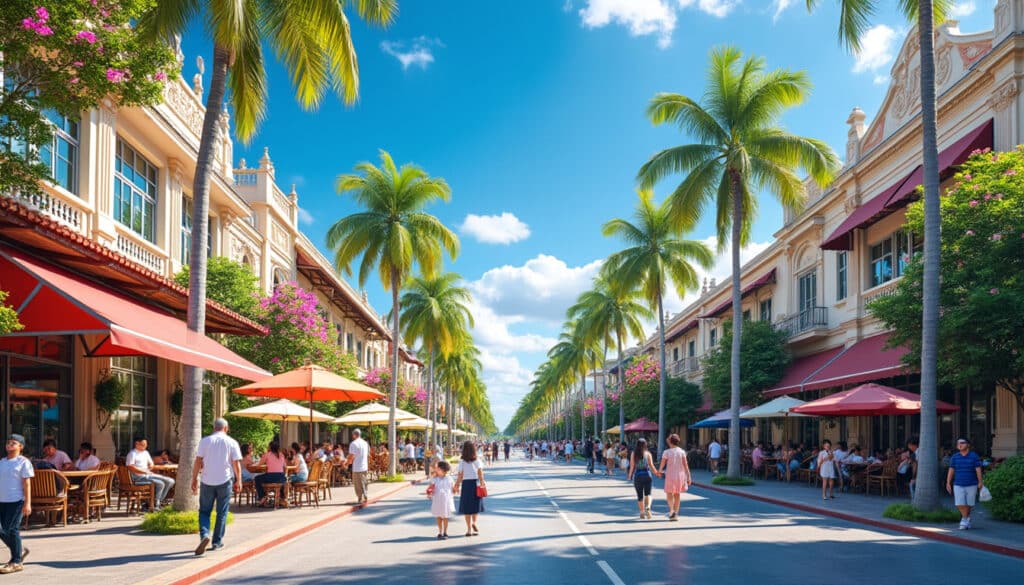
What is the weather like in Johor Bahru?
Experiencing the weather in Johor Bahru offers a dynamic adventure for any urban explorer or street food aficionado. The climate, characterized by warmth and tropical appeal, reflects the vibrancy of this Malaysian city. Whether you’re planning a visit or residing…

